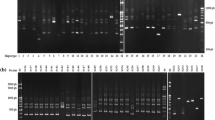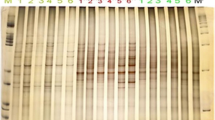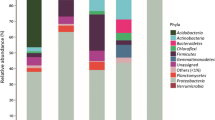Abstract—
Molecular biological and cultivation-based approaches were used to investigate the microbial community of tehnogenic soil contaminated with poorly degradable toxic (chlorinated) aromatic compounds. Diversity of the bphA1 genes, the key genes for the degradation of biphenyl/polychlorinated biphenyls (PCB) was assessed, and new bacterial degraders of biphemyl/PCB were isolated. Cloning of the PCR product obtained using the DNA isolated from soil as a template and the primers to the biphenyl 2,3-dioxygenase α-subunit gene (bphA1) revealed two types of the genes of aromatic dioxygenases (DO) with the highest similarity (97.8‒99.5%) to the genes encoding the Rieske cluster of DO α-subunits (bphA1) from uncultured bacteria. Two biphenyl-degrading isolates obtained from an enrichment culture of a soil sample incubated with biphenyl were identified as Pseudomonas (VRP2-6 and VRP2-2). According to their 16S rRNA gene sequences, they exhibited the highest similarity to the type strain of P. taiwanensis (99%) and P. alcaligenes (100%), respectively. Analysis of the bphA1 sequences of strains VRP2-6 and VRP2-2 revealed the similarity to those of the known biphenyl-degrading pseudomonads not exceeding 97.3%. The isolate VRP2-6 efficiently utilized ortho- and para-monochlorinated biphenyls and degraded dichlorinated biphenyl oxidizing both the ortho- and para-chlorinated rings of the biphenyl molecule. New pseudomonad strains may be of interest for development of biotechnologies aimed at monitoring and remediation of biphenyl/PCB-contaminated soils.




Similar content being viewed by others
REFERENCES
Adebusoye, S.A., Picardal, F.W., Ilori, M.O., Amund, O.O., Fuqua, C., and Grindle, N., Growth on dichlorobiphenyls with chlorine substitution on each ring by bacteria isolated from contaminated African soils, Appl. Microbiol. Biotechnol., 2007, vol. 74, pp. 484–492.
Aguirre de Cárcer, D., Martín, M., Karlson, U., and Rivillam R., Changes in bacterial populations and in biphenyl dioxygenase gene diversity in a polychlorinated biphenyl-polluted soil after introduction of willow trees for rhizoremediation, Appl. Environ. Microbiol., 2007, vol. 73, pp. 6224–6232.
Cébron, A., Norini, M.P., Beguiristain, T., and Leyval C., Real-Time PCR quantification of PAH-ring hydroxylating dioxygenase (PAH-RHDα) genes from Gram positive and Gram negative bacteria in soil and sediment samples, J. Microbiol. Methods, 2008, vol. 73, pp. 148‒159.
Chae, J.-C., Kim, E., Park, S.-H., and Kim, C.-K., Catabolic degradation of 4-chlorobiphenyl by Pseudomonas sp. DJ-12 via consecutive reaction of meta-cleavage and hydrolytic dechlorination, Biotechnol. Bioproc. Eng., 2000, vol. 5, pp. 449‒455.
Chakraborty, J. and Das, S., Characterization of the metabolic pathway and catabolic gene expression in biphenyl degrading marine bacterium Pseudomonas aeruginosa JP-11, Chemosphere, 2016, vol. 144, pp. 1706–1714.
Egorova, D.O., Korsakova, E.S., Demakov, V.A., and Plotnikova, E.G., Degradation of aromatic hydrocarbons by the Rhodococcus wratislaviensis KT112-7 isolated from waste products of a salt-mining plant, Appl. Biochem. Microbiol., 2013, vol. 49, pp. 244–255.
Fierer, N., Jackson, J.A, Vilgalys, R., and Jackson, R.B., Assessment of soil microbial community structure by use of taxon-specific quantitative PCR assays, Appl. Environ. Microbiol., 2005, vol. 71, pp. 4117–4120.
Fujihara, H., Yamazoe, A., Hosoyama, A., Suenaga, H., Kimura, N., Hirose, J., Watanabe, T., Futagami, T., Goto, M., and Furukawa, K., Draft genome sequence of Pseudomonas aeruginosa KF702 (NBRC 110665), a polychlorinated biphenyl-degrading bacterium isolated from biphenyl-contaminated soil, Genome Announc., 2015, vol. 3, no. 3, e00517-15.
Furukawa, K., Hayase, N., Taira, K., and Tomizuka, N., Molecular relationship of chromosomal genes encoding biphenyl/polychlorinated biphenyl catabolism: some soil bacteria possess a highly conserved bph operon, J. Bacteriol., 1989, vol. 171, pp. 5467‒5472.
Furukawa, K., Suenaga, H., and Goto, M., Biphenyl dioxygenases: functional versatilities and directed evolution, J. Bacteriol., 2004, vol. 186, pp. 5189–5196.
Hatamian-Zarmi, A., Shojaosadati, S.A., Vasheghani-Farahani, E., Hosseinkhani, S., and Emamzadeh, A., Extensive biodegradation of highly chlorinated biphenyl and Aroclor 1242 by Pseudomonas aeruginosa TMU56 isolated from contaminated soils, Int. Biodeterior. Biodegr., 2009, vol. 63, pp. 788‒794.
Iwai, S., Chai, B., Sul, W.J., Cole, J.R., Hashsham, S.A., and Tiedje, J.M., Gene-targeted-metagenomics reveals extensive diversity of aromatic dioxygenase genes in the environment, ISME J., 2010, vol. 4, pp. 279–285.
Jurelevicius, D., Alvarez, V.M., Peixoto, R., Rosado, A.S., and Seldin, L., Bacterial polycyclic aromatic hydrocarbon ring-hydroxylating dioxygenases (PAH-RHD) encoding genes in different soils from King George Bay, Antarctic Peninsula, Appl. Soil Ecol., 2012, vol. 55, pp. 1‒9.
Kahl, S. and Hofer, B., A genetic system for the rapid isolation of aromatic-ring-hydroxylating dioxygenase activities, Microbiology (UK), 2003, vol. 149, pp. 1475–1481.
Kim, S.F. and Picardal, W., Microbial growth on dichlorobiphenyls chlorinated on both rings as a sole carbon and energy source, Appl. Environ. Microbiol., 2001, vol. 64, pp. 1953–1955.
Kimura, N., Watanabe, T., Suenaga, H., Fujihara, H., Futagami, T., Goto, M., Hanada, S., and Hirose, J., Pseudomonas furukawaii sp. nov., a polychlorinated biphenyl-degrading bacterium isolated from biphenyl-contaminated soil in Japan, Int. J. Syst. Evol. Microbiol., 2018, vol. 68, pp. 1429‒1435.
Li Q., Wang X., Yin G., Gai Z., Tang H., Ma C., Deng Z., Xu P., New metabolites in dibenzofuran cometabolic degradation by a biphenyl-cultivated Pseudomonas putida strain B6-2, Environ. Sci. Technol., 2009, vol. 43, pp. 8635–8642.
Maltseva, O.V., Tsoi, T.V., Quensen, J.F., III, Fukuda, M., and Tiedje, J.M., Degradation of anaerobic reductive dechlorination products of Aroclor 1242 by aerobic bacteria, Biodegradation, 1999, vol. 10, pp. 363‒371.
Manual of Methods for General Bacteriology, Gerhardt, P., Murray, R.G.E., Costilow, R.N., Nester, E.W., Wood, W.A., Krieg, N.R., and Phillips, G.B., Eds., Washington: Amer. Soc. Microbiol., 1981 [Russ. Transl. Moscow: Mir, 1983].
Master, E.R. and Mohn, W.W., Induction of bphA, encoding biphenyl dioxygenase, in two polychlorinated biphenyl-degrading bacteria, psychrotolerant Pseudomonas strain Cam-1 and mesophilic Burkholderia strain LB400, Appl. Environ. Microbiol., 2001, vol. 67, pp. 2669‒2676.
Nam, I.-H., Chon, C.-M., Jung, K.-Y., and Kim, J.-G., Biodegradation of biphenyl and 2-chlorobiphenyl by a Pseudomonas sp. KM-04 isolated from PCBs-contaminated coal mine soil, Bull. Environ. Contam. Toxicol., 2014, vol. 93, pp. 89–94.
Pieper, D.H. and Seeger, M., Bacterial metabolism of polychlorinated biphenyls, J. Mol. Microbiol. Biotechnol., 2008, vol. 15, pp. 121–138.
Ridl, J., Suman, J., Fraraccio, S., Hradilova, M., Strejcek, M., Cajthaml, T., Zubrova, A., Macek, T., Strnad, H., and Uhlik, O., Complete genome sequence of Pseudomonas alcaliphila JAB1 (=DSM 26533), a versatile degrader of organic pollutants, Stand. Genomic Sci., 2018, vol. 13: 3.
Rozanova, E.P. and Nazina, T.N., Hydrocarbon-oxidizing bacteria and their activity in oil pools, Microbiology (Moscow), 1982, vol. 51, pp. 287–293.
Sharma, J.K., Gautam, R.K., Nanekar, S.V., Weber, R., Singh, B.K., Singh, S.K., and Juwarkar, A.A., Advances and perspective in bioremediation of polychlorinated biphenyl-contaminated soils, Environ. Sci. Pollut. Res., 2018, vol. 25, pp. 16355‒16375.
Short Protocols in Molecular Biology, 3rd ed., Ausbel, F.M., Brent, R., Kingston, R.E., Moore, D.D., Seidman, J.G., Smith, J.A., and Struhl, K., Eds., New York: Wiley, 1995.
Shumkova, E.S., Egorova, D.O., Boronnikova, S.V., and Plotnikova, E.G., Polymorphism of the bphA genes in bacteria destructing biphenyl/chlorinated biphenils, Mol. Biol. (Moscow), 2015, vol. 49, pp. 569–580.
Standfuss-Gabisch, C., Al-Halbouni, D., and Hofer, B., Characterization of biphenyl dioxygenase sequences and activities encoded by the metagenomes of highly polychlorobiphenyl contaminated soils, Appl. Environ. Microbiol., 2012, vol. 78, pp. 2706–2715.
Suenaga, H., Fujihara, H., Kimura, N., Hirose, J., Watanabe, T., Futagami, T., Goto, M., Shimodaira, J., and Furukawa, K., Insights into the genomic plasticity of Pseudomonas putida KF715, a strain with unique biphenyl-utilizing activity and genome instability properties, Environ. Microbiol. Rep., 2017, vol. 9, pp. 589‒598.
Suenaga, H., Yamazoe, A., Hosoyama, A., Kimura, N., Hirose, J., Watanabe, T., Fujihara, H., Futagami, T., Goto, M., and Furukawa, K., Draft genome sequence of the polychlorinated biphenyl-degrading bacterium Pseudomonas putida KF703 (NBRC 110666) isolated from biphenyl-contaminated soil, Genome Announc., 2015, vol. 3, no. 2, e00142-15.
Vasil’ev, A.V., Methodological approaches to classification of cooling and lubricating fluids and assessment of their toxicological effect on humans and the biosphere, Izv. Samar. Nauch. Tsentr RAN, 2017, vol. 19, no. 5(2), pp. 235‒241.
Vasilyeva, G.K. and Strijakova E.R., Bioremediation of soils and sediments contaminated by polychlorinated biphenyls, Microbiology (Moscow), 2007, vol. 76, pp. 639–653.
Versalovic, J., Schneider, M., de Bruijn, F.J., and Lupski, J.R., Genomic fingerprinting of bacteria using repetitive sequence-based polymerase chain reaction, Meth. Cell. Mol. Biol., 1994, vol. 5, pp. 25‒40.
Vezina, J., Barriault, D., and Sylvestre M., Diversity of the C-terminal portion of the biphenyl dioxygenase large subunit, J. Mol. Microbiol. Biotechnol., 2008, vol. 15, pp. 139–151.
Watanabe, T., Yamazoe, A., Hosoyama, A., Fujihara, H., Suenaga, H., Hirose, J., Futagami, T., Goto, M., Kimura, N., and Furukawa, K., Draft genome sequence of Pseudomonas toyotomiensis KF710, a polychlorinated biphenyl-degrading bacterium isolated from biphenyl-contaminated soil, Genome Announc., 2015, vol. 3, no. 3, e00223-15.
Funding
This study was carried out as part of the government task (project no. 01201353249).
Author information
Authors and Affiliations
Corresponding author
Ethics declarations
Сonflict of interests. The authors declare that they have no conflict of interest.
Statement on the welfare of animals. This article does not contain any studies involving animals performed by any of the authors.
Additional information
Translated by A. Panyushkina
Rights and permissions
About this article
Cite this article
Voronina, A.O., Egorova, D.O., Korsakova, E.S. et al. Diversity of the bphA1 Genes in a Microbial Community from Anthropogenically Contaminated Soil and Isolation of New Pseudomonads Degrading Biphenyl/Chlorinated Biphenyls. Microbiology 88, 433–443 (2019). https://doi.org/10.1134/S0026261719030172
Received:
Revised:
Accepted:
Published:
Issue Date:
DOI: https://doi.org/10.1134/S0026261719030172




